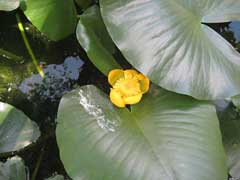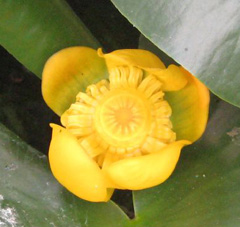 |
|
http://www.flickr.com/photos/8435962@N06 |
 |
| Claire Houck wikimedia.org |
Translate this page:
Summary
Physical Characteristics
![]()
![]() Nuphar advena is a PERENNIAL.
Nuphar advena is a PERENNIAL.
See above for USDA hardiness. It is hardy to UK zone 3. It is in flower from July to August. The species is hermaphrodite (has both male and female organs) and is pollinated by Flies, beetles.
Suitable for: light (sandy), medium (loamy) and heavy (clay) soils. Suitable pH: mildly acid, neutral and basic (mildly alkaline) soils. It can grow in semi-shade (light woodland) or no shade. It can grow in water.
UK Hardiness Map
US Hardiness Map
Synonyms
N. lutea advena. (Ait.)Kartesz.&Gandhi.
Plant Habitats
Pond;
Edible Uses
Edible Parts: Root Seed
Edible Uses:
Root - raw or cooked[2, 62, 161, 183]. The root can be soaked in water in order to remove a bitter taste[85]. After long boiling, it has a taste like sheep's liver[2]. The root can also be dried and ground into a powder then used as a thickener in soups, or can be added to cereal flours when making bread, cakes etc[85, 213]. Seed - raw or cooked. It can be roasted, then ground into a powder and eaten raw[213] or used to thicken soups etc[2, 62, 85, 183, 213]. The seed can also be toasted like popcorn[257].
References More on Edible Uses
Medicinal Uses
Plants For A Future can not take any responsibility for any adverse effects from the use of plants. Always seek advice from a professional before using a plant medicinally.
Anodyne Astringent Demulcent Dysentery Poultice Styptic
The fresh root is anodyne, astringent and demulcent[4]. The pulverized dried rhizomes have been used to arrest bleeding[213]. A tea made from the roots is used in the treatment of dysentery, diarrhoea etc[4]. A poultice made from the roots is used in the treatment of swellings, boils, tumours, inflamed skin etc[4, 257].
References More on Medicinal Uses
The Bookshop: Edible Plant Books
Our Latest books on Perennial Plants For Food Forests and Permaculture Gardens in paperback or digital formats.

Edible Tropical Plants
Food Forest Plants for Hotter Conditions: 250+ Plants For Tropical Food Forests & Permaculture Gardens.
More

Edible Temperate Plants
Plants for Your Food Forest: 500 Plants for Temperate Food Forests & Permaculture Gardens.
More

More Books
PFAF have eight books available in paperback and digital formats. Browse the shop for more information.
Shop Now
Other Uses
References More on Other Uses
Cultivation details
A water plant requiring a rich soil and a sunny position. It is best if grown in still water that is up to 60cm deep but it also tolerates slow moving water[200]. Succeeds in light shade[200]. A very ornamental plant[1]. Nuphar advena is extremely variable and intergrades with N . orbiculata , N . ulvacea , and N . sagittifolia in areas where their ranges overlap[270].
References Carbon Farming Information and Carbon Sequestration Information
Temperature Converter
Type a value in the Celsius field to convert the value to Fahrenheit:
Fahrenheit:
The PFAF Bookshop
Plants For A Future have a number of books available in paperback and digital form. Book titles include Edible Plants, Edible Perennials, Edible Trees,Edible Shrubs, Woodland Gardening, and Temperate Food Forest Plants. Our new book is Food Forest Plants For Hotter Conditions (Tropical and Sub-Tropical).
Shop Now
Plant Propagation
Seed - sow as soon as it is ripe in a greenhouse in pots submerged under 25mm of water. Prick out into individual pots as soon as the first true leaf appears and grow them on in water in a greenhouse for at least two years before planting them out in late spring. The seed is collected by wrapping the developing seed head in a muslin bag to avoid the seed being lost. Harvest it 10 days after it sinks below the soil surface or as soon as it reappears[200]. Division in May. Each portion must have at least one eye. Submerge in pots in shallow water until established[56].
Other Names
If available other names are mentioned here
Native Range
NORTHERN AMERICA: Canada (Ontario (southeast)), United States (Connecticut, Indiana, Maine (south), Michigan (south), New Jersey, New York, Ohio, Pennsylvania, Vermont, West Virginia, Kansas (east), Missouri, Illinois, Oklahoma (east), Wisconsin, Alabama, Arkansas, Delaware, District of Columbia, Florida, Georgia, Kentucky, Louisiana, Maryland, Mississippi, North Carolina, South Carolina, Tennessee, Virginia, Texas), Mexico (Coahuila de Zaragoza, Tamaulipas, Veracruz de Ignacio de la Llave). SOUTHERN AMERICA: Cuba
Weed Potential
Right plant wrong place. We are currently updating this section.
Please note that a plant may be invasive in one area but may not in your area so it's worth checking.
Conservation Status
IUCN Red List of Threatened Plants Status :

Growth: S = slow M = medium F = fast. Soil: L = light (sandy) M = medium H = heavy (clay). pH: A = acid N = neutral B = basic (alkaline). Shade: F = full shade S = semi-shade N = no shade. Moisture: D = dry M = Moist We = wet Wa = water.
Now available:
Food Forest Plants for Mediterranean Conditions
350+ Perennial Plants For Mediterranean and Drier Food Forests and Permaculture Gardens.
[Paperback and eBook]
This is the third in Plants For A Future's series of plant guides for food forests tailored to
specific climate zones. Following volumes on temperate and tropical ecosystems, this book focuses
on species suited to Mediterranean conditions—regions with hot, dry summers and cool, wet winters,
often facing the added challenge of climate change.
Read More
Expert comment
Author
(Aiton) W.T. Aiton
Botanical References
200235270
Links / References
For a list of references used on this page please go here
Readers comment
© 2010, Plants For A Future. Plants For A Future is a charitable company limited by guarantee, registered in England and Wales. Charity No. 1057719, Company No. 3204567.